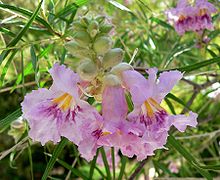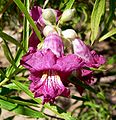
Ptelea trifoliata, commonly known as common hoptree, wafer ash, stinking ash, and skunk bush, is a species of flowering plant in the citrus family (Rutaceae). It is native to North America, where it is found in Canada, Mexico, and the United States. It is a deciduous shrub or tree, with alternate, trifoliate leaves.

Cercis canadensis, the eastern redbud, is a large deciduous shrub or small tree, native to eastern North America from southern Michigan south to central Mexico, west to New Mexico. Species thrive as far west as California and as far north as southern Ontario. It is the state tree of Oklahoma. The prevalence of the so-called "Columbus strain" has seen the residents of Columbus, Wisconsin embrace the plant into their city's identity. Known as the "Redbud City," the town hosts "Redbud Day" annually the Saturday before Mother's Day, organizing a variety of themed events to recognize the tree.

Fouquieria splendens is a plant indigenous to the Mojave Desert, Sonoran Desert, Chihuahuan Desert and Colorado Desert in the Southwestern United States, and northern Mexico.

Ceanothus is a genus of about 50–60 species of nitrogen-fixing shrubs and small trees in the buckthorn family (Rhamnaceae). Common names for members of this genus are buckbrush, California lilac, soap bush, or just ceanothus. "Ceanothus" comes from Ancient Greek: κεάνωθος (keanōthos), which was applied by Theophrastus to an Old World plant believed to be Cirsium arvense.
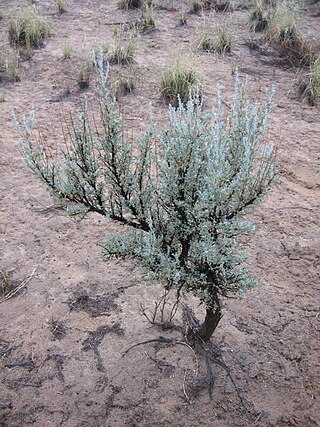
Artemisia tridentata, commonly called big sagebrush, Great Basin sagebrush or simply sagebrush, is an aromatic shrub from the family Asteraceae.

Monarda is a genus of flowering plants in the mint family, Lamiaceae. The genus is endemic to North America. Common names include bergamot, bee balm, horsemint, and oswego tea, the first being inspired by the fragrance of the leaves, which is reminiscent of bergamot orange. The genus was named for the Spanish botanist Nicolás Monardes, who wrote a book in 1574 describing plants of the New World.

Catalpa bignonioides is a short-lived species of Catalpa that is native to the southeastern United States in Alabama, Florida, Georgia, Louisiana, and Mississippi. Common names include southern catalpa, cigartree, and Indian-bean-tree. It is commonly used as a garden and street tree.

Tecoma stans is a species of flowering perennial shrub in the trumpet vine family, Bignoniaceae, that is native to the Americas. Common names include yellow trumpetbush, yellow bells, yellow elder, ginger Thomas. Tecoma stans is the official flower of the United States Virgin Islands and the floral emblem of The Bahamas.

Prunella vulgaris, the common self-heal, heal-all, woundwort, heart-of-the-earth, carpenter's herb, brownwort or blue curls, is an herbaceous plant in the mint family Lamiaceae.

Rubus ursinus is a North American species of blackberry or dewberry, known by the common names California blackberry, California dewberry, Douglas berry, Pacific blackberry, Pacific dewberry and trailing blackberry.
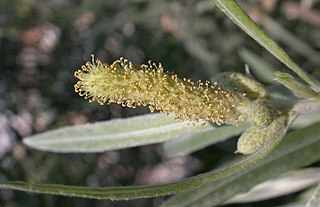
Salix exigua is a species of willow native to most of North America except for the southeast and far north, occurring from Alaska east to New Brunswick, and south to northern Mexico. It is considered a threatened species in Massachusetts while in Connecticut, Maryland, and New Hampshire it is considered endangered.

Olneya tesota is a perennial flowering tree of the family Fabaceae, legumes, which is commonly known as ironwood, desert ironwood, or palo fierro in Spanish. It is the only species in the monotypic genus Olneya. This tree is part of the western Sonoran Desert in Mexico and United States.

Guaiacum angustifolium is a species of flowering plant in the caltrop family, Zygophyllaceae. Common names include Texas guaiacum, Texas lignum-vitae, soapbush and huayacán. It is native to southern and western Texas in the United States and northern Mexico. The specific name is derived from the Latin angustus, meaning "narrow," and -folius, meaning "-leaved".
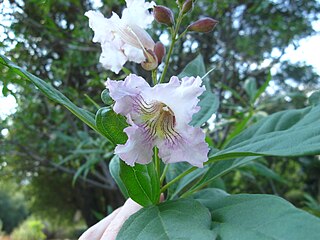
×Chitalpa is an intergeneric hybrid flowering tree in the family Bignoniaceae. There are two major forms in North America, the 'Morning Cloud' a hybrid of desert willow for desert hardiness and color, and northern catalpa, and the 'Pink Dawn' variety formed as a hybrid of desert willow and either yellow catalpa or northern catalpa. Both forms were originally thought to be hybrids of desert willow and southern catalpa. The name is nothogeneric, or a combination of the two parents' names. Leaves are lanceolate, 10 to 13 cm long and 2.5 cm (1 in) wide, almost always in whorls of three. The trumpet-shaped flowers are 2.5 cm (1 in) long and frilly. The inflorescence is indeterminate, with alternately arranged flowers.

Populus fremontii, commonly known as Frémont's cottonwood, is a cottonwood native to riparian zones of the Southwestern United States and northern through central Mexico. It is one of three species in Populus sect. Aigeiros. The tree was named after 19th-century American explorer and pathfinder John C. Frémont.

Persoonia linearis, commonly known as the narrow-leaved geebung, is a shrub native to New South Wales and Victoria in eastern Australia. It reaches 3 m (9.8 ft), or occasionally 5 m (16 ft), in height and has thick, dark grey papery bark. The leaves are, as the species name suggests, more or less linear in shape, and are up to 9 cm (3.5 in) long, and 0.1 to 0.7 cm wide. The small yellow flowers appear in summer, autumn and early winter, followed by small green fleshy fruit known as drupes. Within the genus Persoonia, it is a member of the Lanceolata group of 58 closely related species. P. linearis interbreeds with several other species where they grow together.
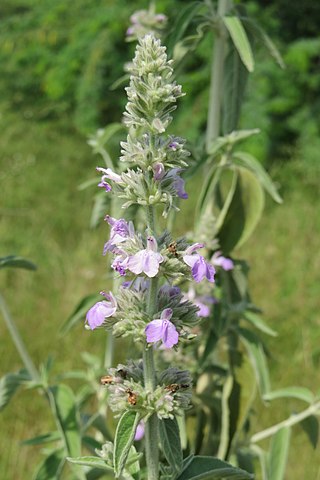
Anisomeles malabarica, more commonly known as the Malabar catmint, is a species of herbaceous shrub in the family Lamiaceae. It is native to tropical and subtropical regions of India, and Sri Lanka, but can also be found in Malaysia, Bangladesh, Myanmar, Bismarck Archipelago, Mauritius, Andaman Islands and Réunion.
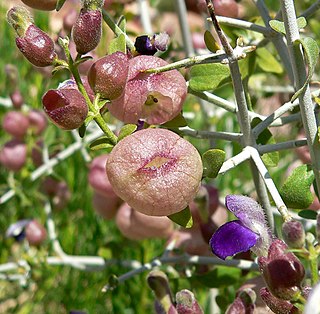
Scutellaria mexicana, commonly known by variants on bladder sage or paperbag bush, is a shrub of the mint family Lamiaceae distinctive for its calyx lobes that develop into small bag- or bladder-like shells around the fruits.
The Burns Piñon Ridge Reserve is a 303-acre nature reserve that is part of the University of California Natural Reserve System. It is located near Yucca Valley, California in San Bernardino County, California. Administered by UC Irvine, the reserve is owned by the University of California and managed for teaching and research.

Catalpa fargesii, the Chinese bean tree, is a species of tree in the family Bignoniaceae, native to China. Growing to about 25 m tall, it is a deciduous tree which produces abundant pink blossom in spring, followed by narrow brown beans-like fruit in the autumn. Some sources place the species as a synonym of Catalpa bungei.
